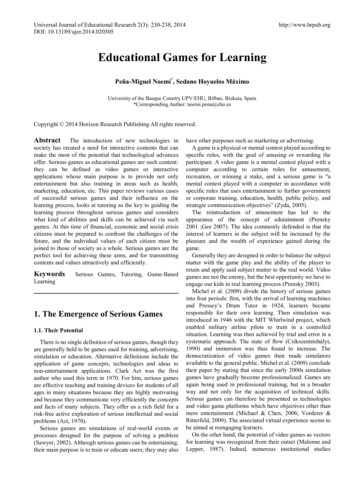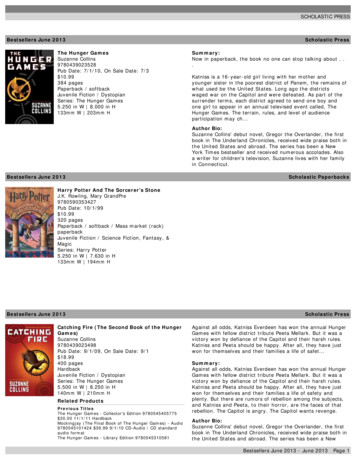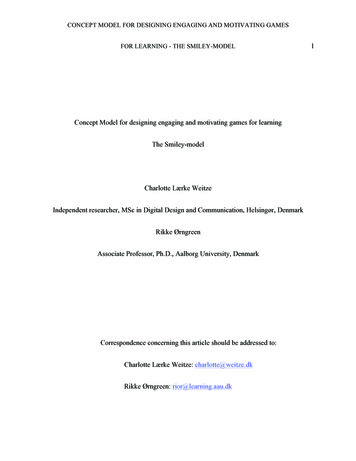
Transcription
Universal Journal of Educational Research 2(3): 230-238, 2014DOI: tional Games for LearningPeña-Miguel Noemí*, Sedano Hoyuelos MáximoUniversity of the Basque Country UPV/EHU, Bilbao, Bizkaia, Spain*Corresponding Author: noemi.pena@ehu.esCopyright 2014 Horizon Research Publishing All rights reserved.AbstractThe introduction of new technologies insociety has created a need for interactive contents that canmake the most of the potential that technological advancesoffer. Serious games as educational games are such content:they can be defined as video games or interactiveapplications whose main purpose is to provide not onlyentertainment but also training in areas such as health,marketing, education, etc. This paper reviews various casesof successful serious games and their influence on thelearning process, looks at tutoring as the key to guiding thelearning process throughout serious games and considerswhat kind of abilities and skills can be achieved via suchgames. At this time of financial, economic and social crisiscitizens must be prepared to confront the challenges of thefuture, and the individual values of each citizen must bejoined to those of society as a whole. Serious games are theperfect tool for achieving these aims, and for transmittingcontents and values attractively and efficiently.KeywordsLearningSerious Games, Tutoring, Game-Based1. The Emergence of Serious Games1.1. Their PotentialThere is no single definition of serious games, though theyare generally held to be games used for training, advertising,simulation or education. Alternative definitions include theapplication of game concepts, technologies and ideas tonon-entertainment applications. Clark Act was the firstauthor who used this term in 1970. For him, serious gamesare effective teaching and training devices for students of allages in many situations because they are highly motivatingand because they communicate very efficiently the conceptsand facts of many subjects. They offer us a rich field for arisk-free active exploration of serious intellectual and socialproblems (Act, 1970).Serious games are simulations of real-world events orprocesses designed for the purpose of solving a problem(Sawyer, 2002). Although serious games can be entertaining,their main purpose is to train or educate users; they may alsohave other purposes such as marketing or advertising.A game is a physical or mental contest played according tospecific rules, with the goal of amusing or rewarding theparticipant. A video game is a mental contest played with acomputer according to certain rules for amusement,recreation, or winning a stake, and a serious game is "amental contest played with a computer in accordance withspecific rules that uses entertainment to further governmentor corporate training, education, health, public policy, andstrategic communication objectives” (Zyda, 2005).The reintroduction of amusement has led to theappearance of the concept of edutainment (Prensky2001 ;Gee 2007). The idea commonly defended is that theinterest of learners in the subject will be increased by thepleasure and the wealth of experience gained during thegame.Generally they are designed in order to balance the subjectmatter with the game play and the ability of the player toretain and apply said subject matter to the real world. Videogames are not the enemy, but the best opportunity we have toengage our kids in real learning process (Prensky 2003).Michel et al. (2009) divide the history of serious gamesinto four periods: first, with the arrival of learning machinesand Pressey’s Drum Tutor in 1924, learners becameresponsible for their own learning. Then simulation wasintroduced in 1946 with the MIT Whirlwind project, whichenabled military airline pilots to train in a controlledsituation. Learning was then achieved by trial and error in asystematic approach. The state of flow (Csíkszentmihályi,1990) and immersion was thus found to increase. Thedemocratization of video games then made simulatorsavailable to the general public. Michel et al. (2009) concludetheir paper by stating that since the early 2000s simulationgames have gradually become professionalized: Games areagain being used in professional training, but in a broaderway and not only for the acquisition of technical skills.Serious games can therefore be presented as technologiesand video game platforms which have objectives other thanmere entertainment (Michael & Chen, 2006; Vorderer &Ritterfeld, 2009). The associated virtual experience seems tobe aimed at reengaging learners.On the other hand, the potential of video games as vectorsfor learning was recognized from their outset (Malonne andLepper, 1987). Indeed, numerous institutional studies
Universal Journal of Educational Research 2(3): 230-238, 2014(Federation of American Scientists, 2006; Project Tomorrow,2008) confirmed the idea that video games could provideplayers with skills that were useful on a degree course andwhich could, moreover, be transferred to the business world.However, some researchers believe that regard for theintrinsic value of games as a means of education needs to betempered (de Freitas, 2006; Pivec & Pivec, 2009). There aretwo main reasons: on the one hand, the application of seriousgames in the field of education is very recent. On the otherhand, little is known about the use of serious games in theeducation system, so data collection is a priority (Ulicsak &Wright, 2010).Besides, some initiatives were carried out, for example in2002, the “Woodrow Wilson International Center” forScholars in Washington D.C. launched a "Serious GamesInitiative" to encourage the development of games thataddress policy and management issues. In 2008, ProjectTomorrow in its report explained that educational gameshelp today s students to be well prepared and to betomorrow s innovators, leaders and engaged citizens of theworld (Project Tomorrow, 2008).In this way, nowadays, there is substantial interest inserious games for formal education, professional training,healthcare, advertising, public policy and social change.Furthermore, games have become a new form ofinteractive content and game playing provides an interactive,collaborative platform for learning purposes: Digital gamesthat allow collaborative learning produce new ideas as wellas exchanging information, simplifying problems, andresolving tasks (Pivec & Pivec, 2011).The potential of serious games is also evident in the factthat they can easily be adapted to any technological formatand can be used on desktop equipment or on mobile devicesof all kinds such as iPads and tablets. However before theyare implemented there are points that needs to be borne inmind: it is necessary to determine what the target audience is,how much time is available for the games and what skills andcompetences are to be promoted. Depending on these points,it must be decided which platforms are best suited to theirimplementation. The term "multiplatform" is used for allkinds of digital content. The appearance of programmingenvironments such as HTML5 (at Internet browser level) andUNITY for downloadable applications on mobile devicesenables serious games to be developed for various platformssimultaneously.1.2. The Relevancy of TutoringOne of the most crucial factors for successful educationalgames is their ability to maintain an individual learner’smotivation and interest by adapting the individual learningand gaming experience to each learner’s needs, preferences,goals, and abilities (Kickmeier-Rust et al 2011). In achievingthis, the role of the tutor is highly important, and severalresearchers are working in this area. The idea comes from thefield of adaptive/intelligent tutoring in conventionaltechnology-supported teaching and learning, basically231inspired by Benjamin Bloom, who stated in 1984 thatstudents who received one-to-one tutoring performed onaverage as well as the top two percent of those receivingclassroom instructions.Since then psychologists, instructors, and technicians haveattempted to develop technology capable of taking the role ofa private teacher and intelligently providing individuallearners with suitable tutoring. The spectrum of approaches,methods, frameworks, and applications used is quite broad(De Bra, 2008; Kinshuk, Lin, & Patel, 2006).Serious games need tutoring and dynamization: withoutthem the learning process is not completed (Garris et al,2002). This tutoring enables any abnormal behavior on thepart of the user to be monitored, and helps preventinappropriate behavior which is possible in theory butsocially unacceptable (Wainess, 2007). It also helps promotethe added value that serious games bring to the educationprocess (on-site or on-line learning processes). The workinvolved in tutoring is the key to guiding the learning processthroughout serious games. On the other hand, someresearchers (Reese, 2007; Kearney and Pivec, 2007 b)believe that serious games help not only in the learningprocess but also in the user s training in the virtual world inwhich the game is conducted.The tutor is an adviser in the education process: not onlydoes he/she provide knowledge to a passive user as in thetraditional education system, but the user also contributeshis/her own previous skills and knowledge to the community.Therefore tutors and learners need to interact and collaboratewithin the education process (Pivec & Pivec, 2011). Thetutor seeks feedback after each decision is implemented.Serious games need basically two elements: good tutoringand a dynamic setting. Otherwise the learning process is notcompleted (Garris et al, 2002). This tutoring enables anyabnormal behavior on the part of the user to be monitoredand helps avoid inappropriate behavior which is possible butsocially unacceptable (Wainess, 2007). It also helps promotethe added value that serious games bring to the educationprocess (on-site or on-line learning processes). The workinvolved in tutoring is the key to guiding the learning processin serious games and that work should involve the followingspecific key points: Drawing up a list of the objectives to be pursued inthe serious games used. Developing a teaching guide to determine whatconcepts are to be reinforced by the serious gamesand what competences they can be used to promote. Defining a framework for the tutor to follow and atthe same time see if the aims have been met. In thissense, there must be continual feedback to addressany points that might discourage the user (he/shecannot continue the game; he/she has difficulties orhas started badly). Establishing a final feedback tool for the wholegroup to compare the results of each user in withthose of the rest of the group. Assessing the opportunities for interaction provided,
232 Educational Games for Learninghow and when the game triggers moments ofreflection in the user experience and whatassessment mechanisms it can handle for gauging theknowledge and understanding acquired by thelearner (Michel et al, 2009).The use of serious games as a learning method ininitial training needs to take into account the profilesof the learners and in particular their previousexperience in the field studied. This could bemonitored by suitable tutoring.2. Serious games that are Easy toDevelop and UseWe concentrate here on “academic serious games” whichare used for simulation purposes in initial training.2.1. PanelSome researchers (Reese, 2007; Kearney and Pivec, 2007b) believe that serious games not only help in the learningprocess but also increase users’ knowledge of the virtualworld or virtual space in which the game takes place.In this game, the players have to answer questions on fivetopics distributed in five levels of difficulty. This game usesa question and answer format. When a player on one teamdoes not know the answer the next team can answer thequestion. The rows show the five topics and the columns thefive levels of difficulty. The objective is to obtain the highestscore.It is a game with a television format that involves differentenvironment-related topics and is aimed at different agegroups from primary school to secondary school levels.Serious games have also been used to encourageentrepreneurship and management at vocational trainingcentres, in driving schools and in training processes inprivate and public-sector businesses.Examples include the “Panel” simulator used to reinforcecontents and help learners acquire a truck-driver’s license(called CAP in Spain) and the online Clio Cup drivingsimulator, which accurately reproduces many details of thiscar racing competition in Spain.The driving school that used this game is very content withthe results obtained: 85% of users passed their truck-driver’slicense exam (Figure 1). They are now considering usinganother game to improve the results of people preparing totake their car driver’s license exam.This game has also been used at the University ofSalamanca in Spain as a tool for reinforcing the knowledgeof students in a marketing-related subject taught on thedegree course in Economics and Management. The level oflearner satisfaction was 7.8 points out of 10. Students saidthat the format of the game was very dynamic and motivating.It caught their attention and enabled them to learn, competeand game at the same time.Source: www.gestionet.netFigure 1. Screen from the Panel game2.2. Games for Learning Vocabulary and Numbers.Tik Tak Hitzak and Tik Tak zenbakiak are two games forchildren aged 6 and over. The first is used to teach basicvocabulary in Basque, Spanish and English. The second isused to improve children’s numeracy skills in basicoperations such as additions, subtractions, multiplicationsand divisions. It features a character called Punttu, who takesthe form of a punctuation mark and takes care of thelanguage. The objective is for players to help him to guessthe word or the number which should appear below eachpicture and thus get the maximum score. In the course ofthese games pictures appear on screen and the main charactermust fill the gaps with the help of the learner.There are three levels of difficulty with a number ofdifferent screens featuring enemies and objects to helplearners. In the easy and difficult levels the words havemissing letters and Punttu must fill the gaps. Once one wordis completed the next one appears, and so on.Source: Txapelgames.comFigure 2. Example of Tik tak hitzak
Universal Journal of Educational Research 2(3): 230-238, 2014In this screenshot the main character “Punttu” (the bluedot in the middle of the screen) has to deal with bulls whichappear suddenly and try to prevent him from completing theword (Figure 2).These games have been used in some primary schools inthe Basque Country and all the teachers involved say that theexperience was very positive: students learnt new wordseasily and entertainingly.Moreover, the level of attention shown by all pupils washigher when the teachers worked with these games in class.Source: Txapelgames.comFigure 3. Sample of tik tak zenbakiakIn this game “Punttu” has to deal with birds that try todistract him.82.35% of parents who have gamed with their children saythat both games are very useful in helping young children tolearn basic vocabulary and basic mathematical operations(Figure 3). They therefore consider them to be valuable toolsfor improving children’s learning.2.3. Games based on Trivial Pursuit and on the Game ofGooseThese are board games. Users have to answer to questionswhich are classified in five categories related to differenttopics.This type of game is used in education to elicit questionsand answers. The questions are grouped according to coursesand subjects related to the curriculum of a specific educationstage. Such games (America s Army, Triage Trainer) havebegun to be used also in adult training with contents such assustainability, environmental matters and management. Insome countries the game of Goose is better known as Snakesand Ladders (Great Britain or USA).An example is the game "A Day On the Trail", which isundoubtedly dynamic and entertaining. In this game childrenlearn about green trails in a pleasant, entertaining, originalway. It consists of a virtual board that simulates a green trail233with all its typical elements: tunnels, bridges, stations, plants,and animals. This game was designed for Fundación de losFerrocarriles Españoles [Spanish Railway Foundation] tomake people aware of the former railway lines that had beenturned into walking trails (Figure 4).The players advance along the green trail whilst answeringquestions from different categories: the geography of thetrail, its environment, its cultural heritage, environmentalmatters such as sustainability, health, road safety, etc.It is an educational game aimed at children aged 8-12, andplayers can choose between two levels: one for ages 6 to 8and the other for ages 9 to 12.Source: www.viasverdes.comFigure 4. Sample of the game “A Day On The Trail”The results for this game were very interesting because notonly the children but also their parents learnt a lot due to thehuge range of themes and topics included.It has been used at primary and secondary schools in Spainin working on matters of human and environmental assets.Teachers value its simplicity and the way in which itmotivates children. They value its combination ofentertainment and education, which enables them to involvechildren in their own learning.3. Complex Serious Games for Workingon Contents, Capacities andCompetences: Games for RaisingCompetences and Skills: The “Island”Game3.1. Development of the GameGames of this kind are used to promote innovation amonguniversity students of engineering and students at vocationaltraining centres.The skills and abilities that these games usually develop
234Educational Games for Learningare sustainability, teamwork, solidarity, innovation,creativity, problem-solving, continuous improvement,energy efficiency, mathematical precision, initiative, goalachievement, result orientation, flexibility, and working withthe environment.The player is the mayor of the island and his/her aim is tomaximize the welfare of the inhabitants (the best use ofnatural resources, R&D, infrastructures). He/she mustmanage the economy of the island to achieve the mostsustainable balance (Figure 5).On this island users have access to different sources ofnon-renewable energy: oil, natural gas and uranium. Theyalso have renewable energy sources: water, the sun and thewind. Moreover, since they live on an island they mustproperly manage the little space that is available (Figure 6).In short, the player is elected mayor of the island andhis/her mission is to maximize the use of the resourcesavailable there. The strategies implemented must bear inmind the relevant framework of limitations just as occurs inreality in public management of resources, i.e. a budgetcomprising income and expenditure and possible newproblems caused as a result of the decisions made and thespace involved.Source: www.simuladores-empresariales.comFigure 5. Screenshot of the “Island” GameSource: www.simuladores-empresariales.comSource: www.gestionet.netFigure 6. A report showing results
Universal Journal of Educational Research 2(3): 230-238, 20143.2. Abilities and Skills that can be worked on in the“Island” GameSustainability: The platform posits that the environment tobe managed is highly fragile, and only very carefulmanagement which takes into account the environment as avaluable asset will enable the aims set to be reached.Spirit of innovation: The key to progress in the game is forthe player to bear innovation in mind as a necessarydistinctive element that acts as a driver of competitiveness.This attitude must be applied especially when it becomesclear that strategic investments in R&D&i must almostalways be made if suitable progress is to be achieved [it isimpossible to obtain good results without engaging inresearch]. In any event, the application also gives the userroom to show his/her spirit of innovation in applyingimaginative solutions to problems that can be solved in awide variety of ways.Initiative and entrepreneurship: The game does not mark apath to be followed but rather offers different alternativesdirectly or indirectly, so it is the user as the manager of theisland who must take the different decisions. Users arerewarded for showing initiative in anticipating futureproblems. In addition, the application is related to theprocesses of entrepreneurship in that the user takes the reinsof an island that is going to experience major demographicexpansion in relative terms.Problem-solving: As users manage the island unforeseencircumstances will arise that must be solved in the bestpossible way. Budgetary restrictions will lead managers intodilemmas which must be solved by weighing up what is bestfor the citizenry.Risk-taking: Users cannot predict everything that willhappen in the coming seasons with absolute certainty. Theclimate, river levels, demographic flows, etc. can bepredicted but not known for sure. Taking risks may beprofitable in terms of results, but the citizenry will notforgive any mistakes committed. Whether or not risks are runwill depend on the profile of each user, on how prone he/sheis to take risks, and on his/her ability accurately to assess thescenarios that might arise if different types of risk are taken.Continuous improvement: The game consists ofcontinually bettering oneself. The population will keepgrowing and will shift between the old and new cities, so thatthe challenges that the manager faces will become more andmore difficult.Orientation towards quality: The options in the game thatproduce the best overall results are never the cheapest ones,but rather those that bring elements of quality to the island. Inspecific contexts the cheapest options might work assolutions, but in the long term the best way to obtain successis through research, investment in telecommunications,renewable energy sources, etc.Value of effort: It takes effort to attain the aim of makingprogress season after season. Success is not a short-term aimbut a long-distance race that takes work.Mathematical skills: Many of the decisions to be made call235for the ability to make mathematical calculations, to assessthe likelihood of one event or another occurring, todetermine what points of equilibrium enable the bestoutcomes to be obtained. Mathematical skills must also beused to obtain information from the application, from thepresent context and from past experiences.Analytical skills: when the user has to take decisions, theability to analyze all the information available isundoubtedly key if the right decisions are to be made. It isvery important for users carefully to record all theinformation that they can possibly find in each season forreference in subsequent analyses.Capability for planning and organization: This means theability to determine effectively the ends, goals, aims andpriorities of the tasks to be performed; to organize activities,their timing and the necessary resources and to monitor theprocesses established. The time-frame of the game is wideenough [several virtual years] for proper skills in planning tobe highly important.Strategy skills: On many occasions certain objectives willhave to be abandoned and resources will need to be saved:Present aims must be sacrificed for the sake of reapinggreater benefits in the future.Technological competence: decisions must be takenbearing in mind that sophisticated technologies are beinghandled.Information management capabilities: This means theability to locate, select, order, relate, assess, and valueinformation from different sources.Independent learning: The ability to orient learning moreand more independently, developing initiative andresponsibility from one’s own learning. The manual for theapplication is only the tip of the iceberg: When itsexplanations are insufficient it is the user him/herself whomust draw conclusions and determine what courses of actionmay lead to the best results (even if those actions were notincluded in the explanations given to him/her).Adaptability to different environments: This means theability to adapt to different situations. The randomness of thegame, risk, the variability of the flows between one seasonand another, etc., can lead the user to find him/herself in verydifferent gaming contexts from one season to another.Creativity: The ability to find new, different solutionswhen faced with conventional problems and situations. Theplatform proposes some rules of play with an environmentand an operating system, but they can be managed in verydifferent ways, and thinking differently may bring goodresults.Accuracy: The ability to be accurate and to take care ofevery last detail of the decisions to be made.Responsibility: Managing an entire island and all theresources involved is a big responsibility. No area should beneglected, and only proper, all-round management canmaximize one’s chances of remaining in one’s post seasonafter season.Resource management: The manager has only limitedresources available to try and reach the goals set: a budget
236Educational Games for Learningthat should preferably avoid too great a tax burden, oilreserves that are running out, and even limited physical space,because this is an island. Success in the game depends onmanaging these resources wisely, on being able to makesavings and on investing in the right assets at the right time.distances between the observed responses in the dataset andthe responses predicted by the linear approximation. Theresulting estimator can be expressed by a simple formula,especially in the case of a single regressor on the right-handside (Greene, 2002).3.3. Results of Using the “Island” Game3.4. Variables to Take into AccountFor two years the Provincial Council of Vizcaya in theBasque Country has been staging a competition involvingthe use of the serious game of the Island. The participants are300 university and vocational training students.The purpose of the competition is to instill and foster skillsand abilities in innovation, entrepreneurship, sustainability,public-sector economics, management of natural resources,initiative, client orientation and public awareness in youngpeople.An analysis of the results reveals the following: 70% ofusers obtained a high enough rating from the citizenry to passthe first case set and go on to the second. 80 % of participantswere studying for technical degrees or technical vocationaltraining modules.85% of users gave the game a “very good” or “good”rating as a method for teaching how to manage apublic-sector economy with its natural resources and publicinfrastructures so as to increase the welfare of citizens, while15% rated it as “fair” or “unsuitable”.90% of the teaching staff supporting the students inquestion considers that the game makes a valuablecontribution to students’ learning and gives them a practicalinsight into how public institutions manage natural resourcesand public infrastructures with a view to achieving asustainable balance and increasing the welfare of society.For the Provincial Council of Vizcaya in the BasqueCountry, this project provided a dynamic way of conveyingand fostering a culture of innovation, competences and skillsamong the young people who will be the future managers ofthe province, oriented towards good public management ofresources with a view to assuring better social and economicdevelopment.The cooperation of technical experts from the BasqueGovernment-dependent organization Ente Vasco de Energía[“Basque Energy Organization”] and civil engineeringconsultants from the Water Directorate at the Department ofthe Environment of the Regional Government of Cantabriawas enlisted in setting up the energy and waterinfrastructures used in the game.Mathematical algorithms were drawn up for the seriousgame to provide the basis for a mathematical model thatrelates the results obtained from the different endogenousvariables calculated via the data entered in the exogenousvariables that form part of the whole model.The model that we have used in this study is the ordinaryleast squares (OLS) or linear least squares. It is a method forestimating the unknown parameters in a linear regressionmodel. This method minimizes the sum of squared verticalAim variable which shows if the student achieves theiSerious Games aims. (value 0 , value 1)Score Gained score using the Serious Game (from 0 toi10)Ev. prev.skills Assessment of previous skills evaluation,ithat is, before the game was used.Ev. gained .skills Assessment of gained skills after usingithe gameStudies user s studies. (2 vocational training students,i3 university students)Hours Number of hours that student has dedicated usingithe game.Age Age of the studentiOur objective is to find the influence of these variables inthe assessment of skills that have been gained after using thegame. For this, we take as independent variables Aimi, Scorei, Ev. prev.skills , Studies Hours Age and the dependentiiiiEv.gained.skillsvariable isiIn this way the first model is as follows:After the model was estimated, we could conclude thatthree variables were not very significant in order to explainthe assessment of gained skills after using the game. Thesevariables were the gentle, the age and the studies, thereforethey were excluded from the model. Concerning the gentle isnot relevant for studying the gained skills and the age.According to the age of students, in the sample we are usinga specific section of age between 18 and 26. Relating to thelevel of studies, due to both of type of students (universityand vocational training students) has the same technicalprofile this variable has not a significant influence. Therefore,the final model is shown below.3.5. OLS Regression with Multiple ExplanatoryVariables
Universal Journal of Educational Research 2(3): 230-238, 2014237Table 1. Estim
the added value that serious games bring to the education process (on-site or on-line learning processes). The work involved in tutoring is the key to guiding the learning process in serious games and that work should involve the following specific key points: Drawing up a list of the objectives










